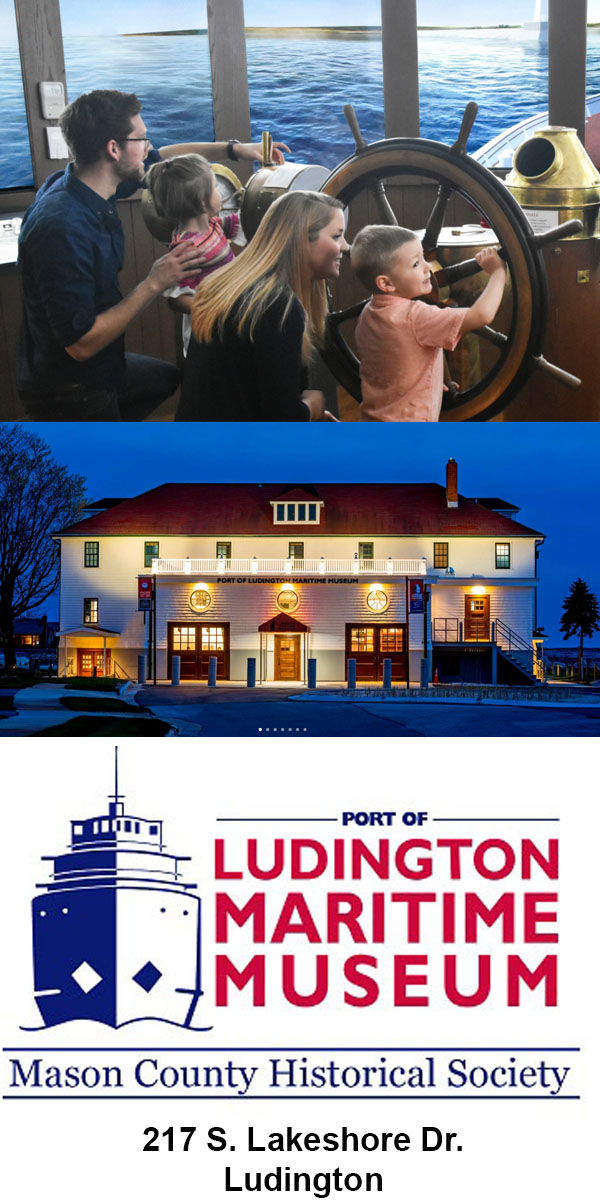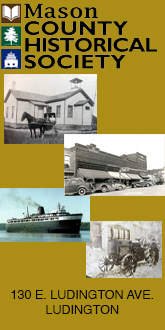
The J.H. Rutter
This MCP Great Lakes History Blog is presented by Filer Credit Union and the Mason County Historical Society.
By Rob Alway, Editor-in-Chief

Capt. Frederick Kendrick
In 1879, Capt. Frederick Kendrick was awarded the United States Gold Lifesaving Medal for his heroic act of saving 44 men from a sinking vessel off the shore of Ludington, near what is now the north end of Stearns Park.
The incident began on Oct. 31, 1878 when the schooner J.H. Rutter, based out of Toledo, had become distressed after losing its rudder near Big Sable Point. The J.H. Rutter was a four-masted vessel of 1,224 tons that was carrying 46,000 bushels of corn and 19,000 bushels of rye, en-route from Chicago.
Crew members from the U.S. Life Saving Service Station Grand Pointe Au Sable, located one mile south of Big Point Sable Lighthouse, had discovered the vessel in a waterlogged condition and labored incessantly for its relief. At that time, the life saving station was the only life saving station north of Pentwater.
Grand Pointe Au Sable station opened just a year earlier, on May 15, 1877, 10 years after the building of the lighthouse. At the time of the Rutter incident, the station was under command of Capt. Sandford “Shanty” Washington Morgan (1823-1904). However, Capt. Morgan was in Detroit at that time, so his son, James Morgan (1848-1924), was in charge. Others on duty included James’s brother, George Morgan (1854-1911), Peter Paasch, Charles Manchester, Wallace Shackleton, and two others.
When the lifesaving crew arrived at the side of the Rutter, its skipper, Capt. Jeremiah “Jerry” Simpson, informed them he needed the vessel towed into port. He also asked for additional men to help shift its cargo.
The Ludington-based tug, Margaret, with a crew of 40 local men, was dispatched. The crew worked into the night and removed 65,000 bushels of grain from the listing vessel. The Margaret was normally commanded by Capt. John Crawford. However, Crawford turned over command to Capt. Robert Caswell, who was Ludington’s most experienced tug operator. The Margaret did not have enough fuel to tow the Rutter, and therefore was assisted by the Goodrich Transportation Company’s S.S. DePere, which towed the Rutter towards Ludington, laying it up in an area described in a Feb. 9, 1954 Ludington Daily News article as being near Tinkham Avenue (about where the Ludington Water Treatment Plant is located today on the north end of Stearns Park).

S.S. DePere
The wooden hulled S.S. De Pere was built in 1873 by Rand & Burger shipbuilders in Manitowoc, Wis. for Goodrich Transportation Co. It was 165 feet long, 29 feet wide and had a depth of 10 feet. It was equipped with a coal-fueled Steeple compound engine. It was sold in 1891 to S.B. Grummond and renamed the State of Michigan in 1892. In 1899-1900 it was sold to Barry Bros. to run between Chicago and Muskegon. It foundered off Montague on Oct. 18, 1901 when a connecting rod on the engine broke, penetrating the hull. The ship was a total loss.
“The men worked far into the night in the hold and ‘tween decks,” the article states.
The J.H. Rutter was 212 feet long with a beam of 38 feet and a depth of 14 feet. It was built in Marine City, Michigan by David Lester in 1873 for Toledo & Saginaw Transportation Company. It was rebuilt in 1874.
The incident and Capt. Kendrick’s honor is recorded in a booklet that was originally published in 1918, prior to Kendrick’s death, and reprinted in September 1981 by the Tri-Cities Historical Society in Grand Haven. An original 1981 booklet is located in the Mason County Historical Society’s Rose Hawley Archives.
The booklet was reproduced by the Tri-Cities Historical Society for the dedication of the Golden Vista on Sept. 5, 1981. The Golden Vista was a former Rock Island observation car which was given to the city of Grand Haven by Charles and Elsie Conrad in memory of Capt. Kendrick, Conrad’s uncle. Charles Conrad, who had grown up in Ludington, was a successful Holland, Mich. businessman and founder of the Community Foundation for Mason County. In 1992, he purchased the last remaining Ludington car ferries and formed Lake Michigan Carferry Service. Read more about his relationship with Kendrick later in this article.

Charles Conrad purchased the Ludington carferries in 1992. He was the nephew of Capt. Kendrick.
That booklet also recalls the plight of the J.H. Rutter and Capt. Kendrick’s involvement.
It states Capt. Simpson was rowed ashore, “where he at once procured the aid of a gang of 36 trimmers to arrange the cargo, which had shifted and listed the vessel over on her side.
“The sea was so rough that the tug which brought the trimmers could not remain and steamed back leaving the men on board.
“After about six hours hard work, just as the vessel was got into navigable condition, a heavy southwest gale blew up, again shifted the cargo, careened the barge on her side, and drove her upon the harbor bar, with the sea rushing completely over her,” the commemorative booklet stated.
In the morning, on Nov. 1, 1848, it was discovered that the cover of the after hatch had been washed off by the huge waves and water was pouring into the hold. The J.H. Rutter was sinking.
“The master slipped anchors so that his ship might not sink in the deep water, and the men took refuge in the rigging,” the 1954 Daily News article stated. “A distress signal, a tiny lantern, hung in the rigging, railed to penetrate the inky darkness.”
The 44 crew members clung to the Rutter’s rigging where they had been since about midnight, exposed to the wintry wind and flying spray.
Life saving station crew members responded and attempted to fire their Lyle gun and lines, but were out of range; they fired seven shots. A Lyle gun was a line thrower shot by a short-barreled cannon.
“By the time the Rutter’s plight was discovered from shore, the storm had lashed the lake into such fury that none of the deep-draft tugs in the harbor could pass over the sand bar just outside the piers. The only shallow-draft tug in the port was the Colonel Graham, part of a government outfit here dredging.”

Capt. Robert Caswell
Due to regulations, the tug’s skipper, Capt. Frederick Kendrick, had to have special orders to take it out.
It was late in the afternoon before permission came from Kendrick’s superior officer.
“The plan chosen was to put a scow in tow, manned by volunteers, with the surf boat behind the scow,” the booklet stated. “The tug accordingly steamed out of the harbor with the two boats in file behind her. Just as soon as she got outside the piers, all hope seemed over. The tug, the scow and the surf boat were thrown furiously about from side to side. At times the three boats entirely disappeared between the seas. For more than an hour this fearful scene continued. At length the tug made sufficient headway to the wreck to enable the surf boat to cut loose, plow up alongside and take off eight men, with which her crew succeeded in reaching the land, though the boat was filled to her gunwales, while the tug made its way back into the harbor with the scow.
“After an abortive effort of the surf boat to reach the wreck again by launching from the harbor, Capt. Kendrick took the boat in tow once more and for hours the terrible scene was repeated of the tug wading and floundering convulsively through the watery avalanches with the surf boat in her rear. Finally the surf boat was taken far enough from shore to hold her own against the sea, and cutting loose from the tug, got sufficiently near to the wreck to cast a line to her, which was caught by the men in the rigging and made fast.
“The surf boat then carried the other end of the line to the shore, the calculation being to set it up and fetch the sufferers to land by the breeches buoy. But the horror of the situation was now increased by the consciousness that the day was waning and that the endeavor for rescue by the means at last arranged must be protracted into the darkness, and involved unknown contingencies of disaster.
“In this exigency, Capt. Kendrick formed the daring resolution of attempting to reach the wreck with the tug, an enterprise which involved the very extreme peril to his vessel and to all on board. The sea had now increased in volume and fury and the vast multitude which lined the piers and beaches hardly breathed as they beheld the sturdy little tug plunging and staggering in her unequal fight with the cataracts which incessantly broke upon her, sometimes flung widely in her course, but ever recovering and holding stubbornly and slowly forward straight for the stranded vessel. The breathless suspense continued as the tug gained the lee of the wreck, and boldly made fast alongside. Slowly one by one, the men were seen leaving the shrouds. At last, a shrill short whistle broke from the tug, and instantly the vast concourse on shore burst into a tempest of cheering.
“The signal of success was understood, and it was known that the men were saved. The shouts and tumult continued as the little tug floundered back to the piers, and just before twilight began to darken, the 36 poor fellows were landed upon the dock amidst a storm of violent exultation, and hurried away to warm rooms, dry clothing, food cordials, attendance, everything they needed.”

The Rutter’s rudder at Epworth
The townspeople turned out that evening for a celebration in Temperance Hall in honor of Capt. Kendrick.
In the spring of 1989, a ship’s rudder washed up on the Lake Michigan shore at Epworth Heights. Since 1991 the rudder has been on display near the intersection of Lincoln and Epworth avenues at Epworth. A plaque, attached to a large rock adjacent to the rudder, doesn’t identify which ship the rudder belonged to. However, it has been documented that the Rutter lost its Rudder during the 1878 storm, leaving one to conclude that it is very likely from that vessel.
In 2024, Richard “Dick” or “Newbs” C. Newberg and his son, Richard A. “Andy” Newberg, published a book, “Do You Have the Rutter’s Rudder?” discussing the Epworth rudder and their family’s connection (a quick and witty read which this writer recommends).
Dick Newberg, born in 1935, grew up in Ludington and graduated from Ludington High School. After college, he moved to Little Rock, Ark., where he resided the rest of his life. He passed away in October 2024. But, he continued to own a house in Ludington and would visit frequently. He was a member of the Mason County Historical Society and also is listed in the Mason County Sports Hall of Fame as a member of the Ludington High School 1952-1953 boys varsity basketball team.
Dick’s great-grandfather, Andrew Newberg, was one of the Ludington men involved in helping the Rutter. Their book is a great account of the rescue of the Rutter and their attempt to acquire a piece of its rudder. It also includes some poems that were written about the account by witnesses to the event.

Plaque located near the rutter
Capt. Frederick Kendrick
Frederick Kendrick was born in England in 1848. On Dec. 25, 1880, he married Emma J. Conrad in Amber Township, Mason County. She was the sister of James B. Conrad, who served as an engineer on the Pere Marquette Railway’s car ferries; James B. Conrad was the father of Charles Conrad, who purchased the last remaining car ferries in 1992 and formed Lake Michigan Carferry Service.
Kendrick entered U.S. government service in 1873. According to the 1981 publication, he was in charge of the tug Colonel Graham at Ludington. According to Emma Kendrick’s obituary, published on July 30, 1942 (she passed away July 29, 1942 at the age of 82), the couple moved to St. Joseph, then later Grand Haven, in 1897 where they resided at 106 Franklin St.

A photograph of the Rutter is “hidden” as an “Easter egg” inside the captain’s quarters of the Pere Marquette 22 replica at the Port of Ludington Maritime Museum.
In Grand Haven, Capt. Kendrick was also in charge of government ships.
The rescue of the men on the J.H. Rutter was just one of many of Kendrick’s acts of heroism.
While still stationed in Ludington, he had rescued a boy who had fallen in a boom of logs.
In 1883, Kendrick, with the tug Graham, rendered assistance to the life saving crew from St. Joseph, which was under the command of Capt. Stevens. The life saving crew, and the Graham came to the aid of the tug Protection near Saugatuck.
The Protection had left St. Joseph en route to Milwaukee with the schooner Argo in tow. After being out several hours the Argo sank, and in getting the men off the tug, got a line in its wheel which completely disabled it.
Later, the steam barge Ackley was able to assist, towing the Protection until the Ackley itself became disabled and sank.
Maritimers the Miller brothers rescued eight men from the Ackley with their yawl boat (Dan Miller was awarded with the gold Medal of Honor).
The Protection drifted nearly across Lake Michigan and came ashore at Saugatuck then laid at anchor on the beach north of the harbor. The anchor then let go and dragged the boat to the south beach. As it passed the harbor one seaman, in despair, jumped overboard and drowned. The remaining 14 men were rescued by the life saving crew about 10 p.m. in a severe snowstorm. The men were taken care of by lighthouse keepers George Baker and Aleck Schriver.
In Grand Haven, Kendrick rescued two boys who had fallen into the water. Kendrick dove into the water and pulled the two boys out, saving them from drowning.
Capt. Kendrick and his wife, Emma, are buried in Lake Forest Cemetery in Grand Haven.

Cover to commemorative booklet dedicated to Capt. Kendrick
Captain Jerry Simpson
Jeremiah “Jerry” Simpson was born on March 31, 1842 at Prince Edward Island, Canada. In 1848, he moved, with his parents, to Oneida County, NY. In 1856, at the age of 14, he became a sailor. Additionally, he served in the American Civil War in Company A, 12th Regiment, Illinois Volunteer Infantry.
Almost immediately after the Rutter incident at Ludington, Simpson left the maritime industry. He moved to Barber County, Kan. near Medicine Lodge and became a farmer. He unsuccessfully ran for Kansas state house of representatives as an independent but in 1891 he was elected to the U.S. House of Representatives as a member of the Populist party. He served two terms from 1891-1895 and then was defeated during re-election in 1894. He was then re-elected in 1896 and served again from 1897-1899. He was then defeated again in 1898 and returned to farming. He died in Wichita, Kan. on Oct. 23, 1905.
Captain Robert Caswell
Robert Caswell was born on May 20, 1834 in Chippewa, Ontario, Canada, the son of Robert and Margaret Caswell. At an early age his family moved to Milwaukee. He began his career in lumbering but then became captain of a ship owned by his father and brother.
Caswell lived at 205 N. Ferry St. in Ludington. He owned several tugboats, often with various businessmen James Ludington, Amos Breinig; David A. Melendy and James Foley. Those tugs included the Cyclone (which was put in service in 1867), the B.W. Aldrich (1871), and the Sport (1877).
In January 1854, he married Elizabeth Daly. They had three children. Elizabeth died of tuberculosis. On Dec. 19, 1872, Caswell married Mary Harbaugh (1846-1932). They had six children together.
Caswell died of a heart attack on May 2, 1889 at the age of 54. He is buried at Lakeview Cemetery.

The J.H. Rutter
Fate of the J.H. Rutter
In 1879, the J.H. Rutter was sold to L. Ellsworth of Milwaukee and then, again that year, to Thomas Adams and Jesse H. Farwell of Detroit; Detroit also became its homeport.
In October 1883, the Rutter had run aground near Detour, Mich. According to a news article, the Rutter had been under tow by the steam barge Farwell but its two line broke while in a heavy southeast gale.
Later Farwell’s share was renamed the Farwell Transportation Company in 1883 and then the Ecorse Transportation Company in 1885. In 1898 it was sold to Atlantic Transportation Company for off-lakes service and left the Great Lakes. It was then used in the coal trade, operating between Newport News, Va. and New York, NY. It ultimately sank on Oct. 23, 1918 in a collision with the steamer Texan, owned by American Havana Line, off North River in New York, NY.
Sources:
Mason County Historical Society Rose Hawley Archives
Tri-County Historical Museum, Grand Haven
Bowling Green University
“Do You Have the Rutter’s Rudder,” by Newberg and Newberg
Ancestry.com


The Mason County Historical Society is a non-profit charitable organization that was founded in 1937 that does not receive any governmental funding. It owns and operates the Port of Ludington Maritime Museum in Ludington, Historic White Pine Village in Pere Marquette Township, and The Rose Hawley Archives and the Mason County Emporium and Sweet Shop in downtown Ludington.
For more information about donating to and/or joining the Mason County Historical Society, visit masoncountymihistory.org.
___________________
Please Support Local News
Receive daily MCP and OCP news briefings along with email news alerts for $10 a month. Your contribution will help us to continue to provide you with free local news.
To sign up, email editor@mediagroup31.com. In the subject line write: Subscription. Please supply your name, email address, mailing address, and phone number (indicate cell phone). We will not share your information with any outside sources. For more than one email address in a household, the cost is $15 per month per email address.
We can send you an invoice for a yearly payment of $120, which you can conveniently pay online or by check. If you are interested in this method, please email editor@mediagroup31.com and we can sign you up. You can also mail a yearly check for $120 to Media Group 31, PO Box 21, Scottville, MI 49454 (please include your email address).
Payment must be made in advance prior to subscription activation.
We appreciate all our readers regardless of whether they choose to continue to access our service for free or with a monthly financial support.
_____
This story and original photography are copyrighted © 2025, all rights reserved by Media Group 31, LLC, PO Box 21, Scottville, MI 49454. No portion of this story or images may be reproduced in any way, including print or broadcast, without expressed written consent.
As the services of Media Group 31, LLC are news services, the information posted within the sites are archivable for public record and historical posterity. For this reason it is the policy and practice of this company to not delete postings. It is the editor’s discretion to update or edit a story when/if new information becomes available. This may be done by editing the posted story or posting a new “follow-up” story. Media Group 31, LLC or any of its agents have the right to make any changes to this policy. Refer to Use Policy for more information.





















































.png)



